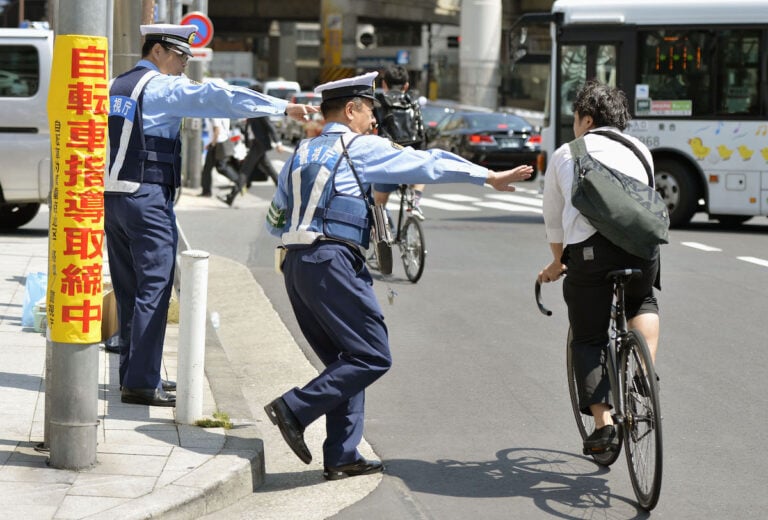
Within the past decade or so, many Japanese commuters sought to avoid crowded trains by adopting the use of bicycles. The increase in cyclists is so significant that it is reported in the news that many municipalities have increased patrolling with the intent of catching traffic violators on bicycles.
The number of bicycle traffic violations in 2021 was 22,859 compared to 2,584 in 2010, an increase of about 10 times, indicating that the National Police Agency is stepping up its enforcement of bicycle traffic laws.
You might be wondering, “what’s the worst that can happen?”
While it might seem that cycling is an innocuous mode of transport, there are violations that if you are caught committing, can land you with a mandatory court appearance and possibly deportation!
If you are already using a bicycle in Japan to get around, you should be well informed already, but just in case, it may be useful to do a review.
Violations with severe punishments
Never ride a bike after consuming alcohol.
If you think that 飲酒運転 (inshu-unten – drunk driving) does not apply to bicycles, beware. This is probably the worst infraction you can commit on a bicycle. According to Article 2, Item 11 of the Road Traffic Law, bicycles are defined as a category of light vehicle, and therefore, like automobiles, there are penalties for drunk driving.
According to data from the National Police Agency, there are more than 100 arrests per year for drunken driving on bicycles, which means that arrests for drunken driving are definitely made even for bicycles.
Furthermore, as with cars, there are penalties of up to five years in prison or a fine of up to 1,000,000 yen for driving a bicycle while intoxicated.
The scary thing about the penalties for bicycling is that, unlike automobiles, there is no penalty system, which means that in some cases, if you are arrested for bicycling, etc., you will be immediately sent to the police for documentary inspection (which can result in imprisonment or a fine).
As a side note, a documented arrest is not equivalent to a criminal record; if the case is subsequently dropped, no criminal record will be issued.

Never cross train tracks when the warning signal starts to ring.
Bicyclists are obligated to temporarily stop at railroad crossings. According to Article 33 of Road Traffic Law (Passage through level crossing): when a vehicle, etc. intends to pass through a level crossing, it must stop immediately before the level crossing (or immediately before the stop line if there is a stop line indicated by a road sign, etc.).
In actuality very few cyclists pause before a railroad crossing. Even when police officers find bicyclists who do not stop just before a railroad crossing, they rarely issue traffic tickets. The exception to this is if you try to speed through a closing level crossing.
If you are not already in the middle of crossing a railroad when the train signal starts, do not attempt to cross. Cyclists caught doing this are certain to have their bicycle impounded and be handed a mandatory court appearance.
In principle, railroad crossings are considered high-risk areas in which traffic violations pose a serious risk of injury and/or death. Criminal procedures for bicycle-related traffic violations tend to be limited to serious cases.
The obstructive driving law
On June 30, 2020, the revised Road Traffic Law went into effect, stipulating harsher penalties for “dangerous conduct”. The revised law applies not only to motor vehicles but also to bicycles. There are 14 types of dangerous acts by cyclists, which are listed below.
| Type of “dangerous act” | Explanation |
|---|---|
| Ignoring signals | Failing to follow signals or police officers' hand signals |
| Violation of traffic prohibition | Passing through places that are closed or prohibited to vehicles |
| Violation of vehicle obligations on sidewalk roads | Failing to be careful of pedestrians when riding on the sidewalk |
| Violation of traffic classification | Violation of not riding on bicycle designated parts of the road |
| Obstruction of pedestrians when passing by the sidewalk | Block pedestrian traffic when passing through the sidewalk |
| Enter the railroad crossing | Violation to enter the railroad crossing when the train signal is on |
| Violation of intersection safety obligation, etc | Violations in the crossing of intersections, etc |
| Intersection priority vehicle obstruction, etc | Failing to respect the right of way at an intersection |
| Violation of safety obligation at roundabouts, etc | Failing to travel clockwise (clockwise) |
| Temporary non-stop at designated place, etc | Stop sign violation |
| Violation of traffic method when passing on the sidewalk | Interfering with pedestrians when riding on the sidewalk |
| Bad braking device (brake) Driving a bicycle | Riding with defective brakes, reflectors and/or taillights |
| Drunk driving | Riding a bicycle under the influence of alcohol |
| Violation of safe driving obligation | Failing to operate the handlebar and brake firmly with both hands |
| Interfering driving | Intentionally obstructing the passage of other cars or pedestrians |
Drivers 14 years of age or older who have been repeatedly caught in the aforementioned dangerous acts two or more times within a three-year period are required to take a safety course under the Bicycle Rider Training Program.
If you are required to take the course, the Public Safety Commission will issue a written order for you to take the course, and you must attend the safety course at a designated location.
If you fail to take the course, you will be fined up to 50,000 yen and have a criminal record.
Methods of Enforcement (yellow paper and red ticket)
There are two types of enforcement for bicycle traffic violations. One is enforcement with a “Bicycle Instruction Warning Card” and the other is enforcement with a “Violation Ticket (Red Ticket)”.
The Bicycle Advisory and Warning Card is a yellow sheet of paper with a description of the violation and is given to the offender. The card is a reminder of the violation and is not subject to enforcement action that will require the offender to take a bicycle operator’s course.
Violations that are subject to penalties will result in the issuance of a violation ticket. This ticket is called a “red ticket. The red tickets are the subject of enforcement actions that require the cyclist to take the aforementioned cyclist training course.
With that, I hope you have found this informative. When on a bicycle, remember to stay safe.

















